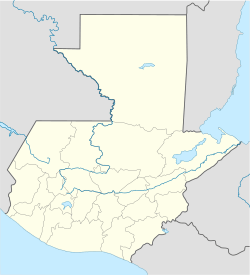Rabinal facts for kids
Quick facts for kids
Rabinal
|
|
|---|---|
|
Municipality
|
|
| Nickname(s):
Rabinal
|
|
| Country | |
| Department | |
| Founded | 1537 |
| Area | |
| • Total | 336 km2 (130 sq mi) |
| Population
(2018 census)
|
|
| • Total | 40,797 |
| • Density | 121.42/km2 (314.5/sq mi) |
| Climate | Aw |
| Website | Official Website of the Municipality of Rabinal: http://www.inforpressca.com/rabinal/galeria.php |
Rabinal is a town in Guatemala, located in the Baja Verapaz Department. In 2018, about 15,157 people lived in the town itself. Rabinal is the main town for the larger area, called a municipality, which had 40,797 people in 2018 and covers 336 square kilometers.
Most people in Rabinal are Achi Maya, who are Native Americans. They speak the Achi Maya language.
Contents
History of Rabinal
Rabinal was started in 1537 by Bartolomé de las Casas. He was exploring the lands of the Maya people.
How Spanish Friars Settled Rabinal
Bartolomé de las Casas was a friar from the Order of Preachers. He visited Guatemala again in 1537. He wanted to teach the Christian faith in a new way. His ideas were:
- Treat all people equally.
- Conversion to Christianity should be a choice. People should understand what they are choosing.
Las Casas wanted to test his method without colonists getting in the way. So, he chose a part of Guatemala where no Spanish colonies existed. The native people there were known for being strong and warlike. The governor of Guatemala, Alonso de Maldonado, agreed to let Las Casas try. He promised not to set up new land grants (called encomiendas) if the plan worked.
Las Casas and his friars started their work in Rabinal, Sacapulas, and Cobán. They even reached Chahal. Because of their efforts, this area, once called the "Land of War," became known as "Verapaz," meaning "True Peace."
Las Casas's plan was to teach Christian songs to Native American merchants. These merchants then traveled into the area and shared the songs. This helped convert several native chiefs, including those from Atitlán and Chichicastenango. Churches were built in the area now called Alta Verapaz. These churches brought together Christian Native Americans in the place that is now Rabinal. In 1538, Las Casas was called away to Mexico and then to Spain to find more friars for his mission.
The large colonial Catholic church in Rabinal was finished in 1572. Bishop Bartolomé de las Casas had started its construction.
In the mid-19th century, Charles Étienne Brasseur de Bourbourg was the local priest. He studied the highland Maya people and collected their folk tales. He also translated documents, including the famous Rabinal Achí, into European languages for the first time. By 1850, Rabinal had about 6,500 people.
Rabinal was a place where many terrible events happened during Guatemala's Civil War. This included the Plan de Sánchez and Río Negro. The town of Rabinal itself also saw a large massacre during an Independence Day celebration in 1981.
How the Friars Organized Communities

After the Spanish conquered the land, the Spanish crown wanted to teach the native people the Catholic faith. New settlements started by royal missionaries were called "Indian doctrines."
At first, friars had a simple goal: teach Catholicism to the natives. Then, these settlements were supposed to become regular church parishes, like those in Spain. The friars were also meant to teach Spanish and Catholicism. Once the natives were ready, they would live in parishes and pay taxes to the church, just like people in Spain.
However, this plan did not work out. The Spanish crown lost control of the religious orders once their friars arrived in America. The missionaries had special permissions to convert natives. They only answered to their own order's leaders, not to the Spanish government or bishops. Once a "doctrine" (settlement) was set up, the friars protected their own interests, even against the King. So, these doctrines became Native American towns that stayed the same throughout the Spanish colonial period.
Friars could start these doctrines wherever they wanted. The main idea was that they would eventually become regular parishes. But in reality, these doctrines grew very large and were never handed over to regular parishes. They grew around the friars' monasteries. From there, friars would go out to preach in smaller settlements called "annexes" or "visit towns."
Doctrines had three main features:
- They were independent from outside control (both church and government).
- They were run by a group of friars.
- They had many smaller "annexes" or "visit towns."
Being run by a group of friars was important. It made sure that the community system would continue smoothly, even if one friar died.
In 1638, the Order of Preachers divided their large doctrines into groups. Each group was centered around one of their six monasteries. The Rabinal doctrine was placed under the control of the Santiago de los Caballeros de Guatemala monastery.
| Monastery | Doctrines |
|---|---|
| Santiago de los Caballeros de Guatemala |
|
Culture and Traditions in Rabinal
Rabinal has a beautiful old church built in the Baroque style. Next to the church is a small museum. It shows local culture, especially traditional healing methods. There is also a section about the sad events of the 1980s massacres. You can also find ancient Maya sites in the hills around the town.
The town's yearly festival, called fiesta patronal, happens in late January. It is famous for its dances. One special dance tells the story of a legendary battle between the Achi and K'iche Maya. This dance, called The Rabinal Achí, is so important that UNESCO has named it a World Heritage Cultural monument.
Climate in Rabinal
Rabinal has a tropical savanna climate. This means it is warm all year, with a wet season and a dry season.
| Climate data for Rabinal | |||||||||||||
|---|---|---|---|---|---|---|---|---|---|---|---|---|---|
| Month | Jan | Feb | Mar | Apr | May | Jun | Jul | Aug | Sep | Oct | Nov | Dec | Year |
| Mean daily maximum °C (°F) | 27.5 (81.5) |
28.8 (83.8) |
30.5 (86.9) |
30.7 (87.3) |
30.0 (86.0) |
28.5 (83.3) |
28.4 (83.1) |
28.7 (83.7) |
28.3 (82.9) |
27.8 (82.0) |
27.7 (81.9) |
27.8 (82.0) |
28.7 (83.7) |
| Daily mean °C (°F) | 20.5 (68.9) |
21.4 (70.5) |
23.1 (73.6) |
23.8 (74.8) |
23.7 (74.7) |
23.2 (73.8) |
23.0 (73.4) |
23.0 (73.4) |
22.7 (72.9) |
22.2 (72.0) |
21.3 (70.3) |
20.8 (69.4) |
22.4 (72.3) |
| Mean daily minimum °C (°F) | 13.5 (56.3) |
14.1 (57.4) |
15.7 (60.3) |
16.9 (62.4) |
17.4 (63.3) |
18.0 (64.4) |
17.6 (63.7) |
17.3 (63.1) |
17.1 (62.8) |
16.6 (61.9) |
15.0 (59.0) |
13.8 (56.8) |
16.1 (61.0) |
| Average precipitation mm (inches) | 5 (0.2) |
9 (0.4) |
10 (0.4) |
24 (0.9) |
90 (3.5) |
188 (7.4) |
125 (4.9) |
69 (2.7) |
132 (5.2) |
84 (3.3) |
27 (1.1) |
6 (0.2) |
769 (30.2) |
| Source: Climate-Data.org | |||||||||||||
Where is Rabinal Located?
 |
Uspantan, municipality of Quiché Department |  |
||
| Cubulco, municipality of Baja Verapaz Department | San Miguel Chicaj, municipality of Baja Verapaz Department | |||
| Santa Cruz El Chol, Granados, municipalities of Baja Verapaz Department | Salamá, municipality of Baja Verapaz Department |
Images for kids
See also
 In Spanish: Rabinal para niños
In Spanish: Rabinal para niños



